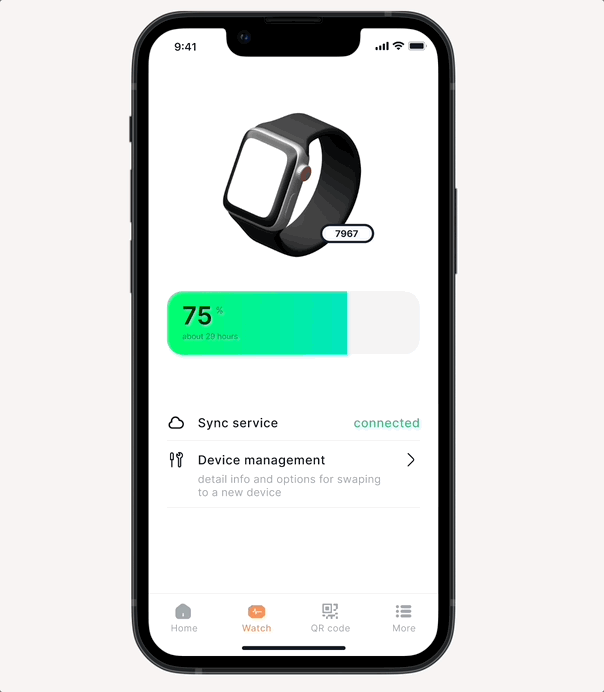Sepsis Scout | Product and UX/UI Designer
Combining deep learning with off-the-shelf wearables to detect early signs of sepsis, making in impact in the lives of 47,000 cancer patients who suffer from the condition.
Role
Product & UX/UI Designer
Timeline
Jan-May, 2024 (4 month contract)
Skills
Wearable prototyping, user research, deep learning

Context
Brief
SepsisScout leverages off-the-shelf smartwatches to measure patients' heart rate, respiration rate, blood pressure, temperature and SpO2 for real-time monitoring of sepsis.
This data is transmitted to a deep learning algorithm in the cloud via a patient’s smartphone. The algorithm then takes this data along with demographic data and medical co-variates, and generates a risk score between zero and one. When this risk score crosses a threshold, the system notifies the treating team, who then alerts the patient to visit the emergency room ASAP.
As a researcher and designer, I streamlined the process of communication of data to ER physicians, building the mobile app platform that ensures patients are treated quickly and accurately.
Meet our Users

Sepsis is one of the biggest killers in the world and is the cause of 1 in every 5 deaths, globally. Currently, sepsis affects 1.7m Americans and directly kills 270k every year. Of the 47,000 cancer patients in the US who died of sepsis, 4 out of 5 could have been saved if the condition had been identified in its early stages.
How Might We Statement
HMW: develop a credible data exchange that ensures seamless communication between ER clinicians and users to facilitate a rapid and personalized sepsis treatment?
User Mapping

User Research
Guiding Questions
How do ER physicians authenticate data, and how do they determine the credibility of similar tools?
01
Where are the pain points in the current data transfer and communication between ER and patient?
02
Our Method
We decided to explore these questions primarily through user interviews, receiving data from 60 ER physicians from 12 different hospitals.
Key Insights
01
Doctors have too many patients to treat at the ER. In the United States, the average ER wait time is 2.5 hours, with some states having wait times of up to 4 hours.
"As an ER doctor, I see too many patients waiting for hours—sometimes up to 5 hours"
02
Doctors need to establish a patient's baseline health history quickly in order to treat their needs as effectively as possible. Namely, they must be provided with the patient's vital metrics.
"I need a patient’s vitals fast to understand their baseline and make the right call under pressure."
03
Some interviewees expressed concern about whether they could reliably trust a product that relies on deep learning models.
"I still worry about trusting deep learning completely when lives are on the line."
QR Code
Prototyping
QR Code
Feature Ideation
01
We wanted a way for doctors to easily access a patient's vital information by quickly scanning a QR Code on the patient's mobile app. We considered this solution because QR codes are a familiar interface and provide a way to relay dense information quickly in a condensed manner.
02
Risk Score
We proposed providing a 'risk score' graphic to indicate to doctors the severity of the sepsis in a way that is easy to digest. This feature was inspired by our interviews, where many doctors mentioned that patients with a confirmed case of sepsis are guaranteed immediate treatment in the ER.
03
Easy Onboarding & Device Pairing
It was important to create a step-by-step, user friendly method to connect and manage wearable devices. The faster users connect, the faster we can provide life-saving treatement.
04
Vital Information Database
With a vital information database, users can track their health history over time, or categorize by day, month, and year. Additionally, we provided a database to log medical history such as medications, physicians, and other important information.
Wireframing
With these research findings in mind, it was time to create a product that displayed baseline health clearly and quickly without sacrificing the quality of vital information. It was also important to establish trust between users (doctors) and the product.
.jpg)
Final Product
Final Product
Introducing a more trustworthy
and fast Sepsis detection solution.

INNOVATIVE ORGANIZATION
Find patient information in seconds.
Patient medical history is organized into pages to make the interface as readable as possible during time-sensitive emergencies.
A scannable QR code is provided for doctors who need more in-depth patient information quickly.


EASY ONBOARDING
Connect your wearable device with ease.
Step-by-step menu to add and manage wearable devices.
VITALS DATABASE
Monitor health with confidence.
Newly designed vitals database to make it easy to monitor health throughout the day, week, or month based on your watch's data.

Musings & Reflections

Team cookie outing after a work sesh
Communication is key🔑
Throughout this process, there was lots of back-and-forth between our team, ER physicians, sepsis patients, and Sepsis Scout exec. It took several iterations to make everyone happy in the end.
Simplifying a process takes a lot of thought🧠
Simplifying UX is all about cutting out the clutter so users can get things done easily. It’s about making things feel smooth and natural, without overthinking it.




